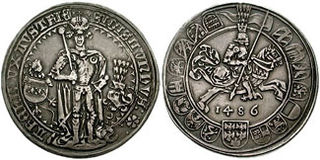
Guilder is the English translation of the Dutch and German gulden, originally shortened from Middle High German guldin pfenninc "gold penny". This was the term that became current in the southern and western parts of the Holy Roman Empire for the Fiorino d'oro. Hence, the name has often been interchangeable with florin.
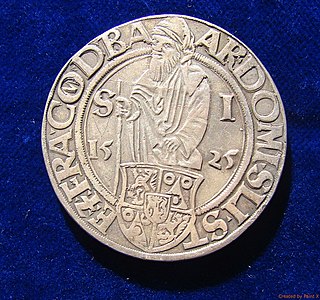
The thaler was a silver coin used throughout Europe for almost four hundred years. Its name lives on in the many currencies called dollar and the Samoan tālā, and, until recently, also in the Slovenian tolar.

A penny is a coin or a unit of currency in various countries. Borrowed from the Carolingian denarius, it is usually the smallest denomination within a currency system. Presently, it is the formal name of the British penny (abbr. p) and the informal name of one American cent (abbr. ¢) as well as the informal Irish designation of 1 cent euro coin (abbr. c). It is the informal name of the cent unit of account in Canada, although one cent coins are no longer minted there. The name is also used in reference to various historical currencies also derived from the Carolingian system, such as the French denier and the German pfennig. It may also be informally used to refer to any similar smallest-denomination coin, such as the euro cent or Chinese fen.

The peso was a coin that originated in Spain and became of immense importance internationally. Peso is now the name of the monetary unit of several countries in America and the Philippines.

The British crown, the successor to the English crown and the Scottish dollar, came into being with the Union of the kingdoms of England and Scotland in 1707. As with the English coin, its value was five shillings.

The dinar is the principal currency unit in several countries and was used historically in several more.

The Spanish dollar, also known as the piece of eight, is a silver coin, of approximately 38 mm diameter, worth eight Spanish reales, that was minted in the Spanish Empire following a monetary reform in 1497.
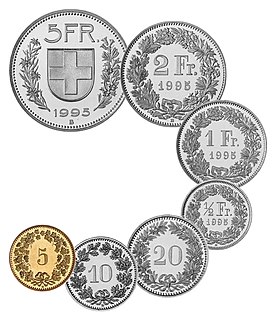
The franc is the currency and legal tender of Switzerland and Liechtenstein; it is also legal tender in the Italian exclave Campione d'Italia. The Swiss National Bank (SNB) issues banknotes and the federal mint Swissmint issues coins.

St. Gallen or traditionally St Gall, in German sometimes Sankt Gallen is a Swiss town and the capital of the canton of St. Gallen. It evolved from the hermitage of Saint Gall, founded in the 7th century. Today, it is a large urban agglomeration and represents the center of eastern Switzerland. Its economy consists mainly of the service sector. Internationally, the town is known as the home of the University of St. Gallen, one of word's leading business schools.

The pfennig or penny is a former German coin or note, which was official currency from the 9th century until the introduction of the euro in 2002. While a valuable coin during the Middle Ages, it lost its value through the years and was the minor coin of the Mark currencies in the German Reich, West and East Germany, and the reunified Germany until the introduction of the euro. Pfennig was also the name of the subunit of the Danzig mark (1922–1923) and the Danzig gulden (1923–1939) in the Free City of Danzig.
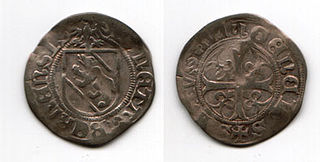
The batzen was a coin produced by Bern, Switzerland, from the 15th century until the mid-19th century.

The ducat was a gold or silver coin used as a trade coin in Europe from the later Middle Ages until as late as the 20th century. Many types of ducats had various metallic content and purchasing power throughout the period. The gold ducat of Venice gained wide international acceptance, like the medieval Byzantine hyperpyron and the Florentine florin, or the modern British Pound sterling and the United States dollar.
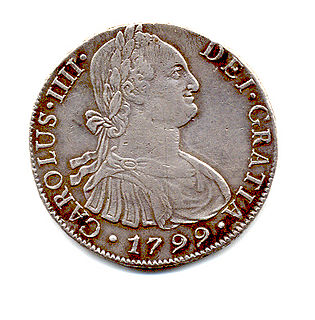
The silver real was the currency of the Spanish colonies in America and the Philippines. In the seventeenth century the silver real was established at two billon reals or sixty-eight maravedís. Gold escudos were also issued. The coins circulated throughout Spain's colonies and beyond, with the eight-real piece, known in English as the Spanish dollar, becoming an international standard and spawning, among other currencies, the United States dollar. A reform in 1737 set the silver real at two and half billon reals or eighty-five maravedís. This coin, called the real de plata fuerte, became the new standard, issued as coins until the early 19th century. The gold escudo was worth 16 reales de plata fuerte.

The Swiss franc has been the currency of Liechtenstein since 1920. The Swiss franc is legal tender since Liechtenstein is in a customs and monetary union with Switzerland. The 1980 treaty between Switzerland and Liechtenstein allows Liechtenstein to mint limited amounts of Swiss francs with a Liechtenstein inscription, but only in the form of commemorative coins, and they are not allowed to issue banknotes.
The Frank was the currency of the Swiss canton of St. Gallen between 1798 and 1850. It was subdivided into 10 Batzen, each of 4 Kreuzer or 16 Pfennig.
This article provides an outline of the currency of Spanish America from Spanish colonization in the 15th century until Spanish American independencies in the 19th. This great realm was divided into the Viceroyalty of New Spain, which came to include all Spanish territory north of Panama, the West Indies, Venezuela, and the Philippines, and the Viceroyalty of Peru, which included Panama and all Spanish territory in South America except Venezuela. The monetary system of Spanish America, originally identical to that of Spain, soon diverged and took on a distinctive character of its own, which it passed on to the independent nations that followed after.

The United States dollar is the official currency of the United States and its territories per the United States Constitution since 1792. In practice, the dollar is divided into 100 smaller cent (¢) units, but is occasionally divided into 1000 mills (₥) for accounting. The circulating paper money consists of Federal Reserve Notes that are denominated in United States dollars.

A shooting thaler is a commemorative coin minted to commemorate one of the Schützenfest or free shooting tournaments held in various cantons within the Swiss Confederation. Most of the designs differ from their circulating counterparts, though the pieces issued for the shooting festivals in Geneva in 1851 and Solothurn in 1855 are exceptions. Most shooting thaler designs depict strongly cantonal or patriotic themes, such as historical military leaders or heraldry. The entire series can be distinguished from shooting medals by their adherence to the specifications of circulating coinage. All but the Stans and St. Gallen issues are denominated. Other countries have minted coins in honor of shooting festivals or marksmanship competitions, but only Swiss pieces are considered shooting thalers.
Rhenish guilder is the name of the golden, base currency coin of the Rhineland in the 14th and 15th centuries. Most were about the size of a modern US dime and weighed between 3.4 and 3.8 grams.

The crown, originally known as the "crown of the double rose", was an English coin introduced as part of King Henry VIII's monetary reform of 1526, with a value of five Shillings.


